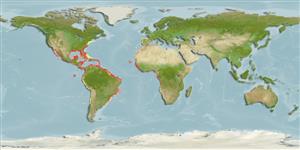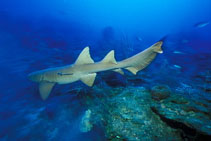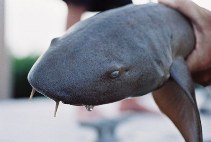Ginglymostoma cirratum (Bonnaterre, 1788)
Nurse shark
Waarneming toevoegen in Fish Watcher
| Native range | All suitable habitat | Point map | Year 2050 |

|
| This map was computer-generated and has not yet been reviewed. |
| Ginglymostoma cirratum AquaMaps Data sources: GBIF OBIS |
Dominican Republic country information
Common names:
Gata
Occurrence: native
Salinity: brackish
Abundance: | Ref:
Importance: | Ref:
Aquaculture: | Ref:
Regulations: | Ref:
Uses: no uses
Comments:
National Checklist:
Country Information: https://www.cia.gov/library/publications/resources/the-world-factbook/geos/dr.html
National Fisheries Authority: ttp://www.cep.unep.org/rep_dom/Rep_Dom.htm#SEA-PESQUERO
Occurrences: Occurrences Point map
Main Ref: Compagno, L.J.V., 1984
National Database:
Occurrence: native
Salinity: brackish
Abundance: | Ref:
Importance: | Ref:
Aquaculture: | Ref:
Regulations: | Ref:
Uses: no uses
Comments:
National Checklist:
Country Information: https://www.cia.gov/library/publications/resources/the-world-factbook/geos/dr.html
National Fisheries Authority: ttp://www.cep.unep.org/rep_dom/Rep_Dom.htm#SEA-PESQUERO
Occurrences: Occurrences Point map
Main Ref: Compagno, L.J.V., 1984
National Database:
Common names from other countries
Classificatie / Names Lokale namen | Synoniemen | Catalog of Fishes(Genus, Soort(en)) | ITIS | CoL | WoRMS | Cloffa
Elasmobranchii (haaien en roggen) (sharks and rays) > Orectolobiformes (Carpet sharks) > Ginglymostomatidae (Nurse sharks)
Etymology: Ginglymostoma: ginglymus (Gr.), hinge; stoma (Gr.), mouth, presumably referring to how corner of mouth has a hinged appearance (See ETYFish); cirratum: Latin for having tendrils, referring to elongated nasal barbels (See ETYFish).
More on author: Bonnaterre.
Etymology: Ginglymostoma: ginglymus (Gr.), hinge; stoma (Gr.), mouth, presumably referring to how corner of mouth has a hinged appearance (See ETYFish); cirratum: Latin for having tendrils, referring to elongated nasal barbels (See ETYFish).
More on author: Bonnaterre.
Environment: milieu / climate zone / depth range / distribution range Ecologie
marien; brak water rifbewoner; diepte 0 - 130 m (Ref. 43278), usually 1 - 35 m (Ref. 40849). Subtropical; 44°N - 35°S, 122°W - 10°E (Ref. 43278)
Verspreiding Landen | FAO regio's | Ecosystemen | Voorkomen | Point map | Introducties | Faunafri
Western Central Atlantic: Rhode Island to southern Brazil (south to Rio de Janeiro), including Gulf of Mexico and Caribbean coasts, although (exceptionally from Rhode Island to Texas), Bermuda; Eastern Central Atlantic: Cape Verde Islands, Senegal, Cameroon to Gabon, and rarely north to Bay of Biscaye, France (ref. 43278). Populations in eastern Pacific refer to Ginglymostoma unami Del Moral-Flores et al., 2015 (Ref. 113902).
Lengte bij maturiteit / Grootte / Gewicht / Leeftijd
Maturity: Lm 235.0, range 230 - 240 cm
Max length : 430 cm TL mannelijk / geslacht onbekend; (Ref. 96339); common length : 304 cm TL mannelijk / geslacht onbekend; (Ref. 247); max. gepubliceerd gewicht: 109.6 kg (Ref. 40637); max. gerapporteerde leeftijd: 25 Jaren (Ref. 72467)
Max length : 430 cm TL mannelijk / geslacht onbekend; (Ref. 96339); common length : 304 cm TL mannelijk / geslacht onbekend; (Ref. 247); max. gepubliceerd gewicht: 109.6 kg (Ref. 40637); max. gerapporteerde leeftijd: 25 Jaren (Ref. 72467)
Korte beschrijving Determinatiesleutels | Morfologie | Morfometrie
Dorsale stekels (totaal) : 0. Moderately long barbels, nasoral grooves present but no perinasal grooves, mouth well in front of eyes, spiracles minute, precaudal tail shorter than head and body, dorsal fins broadly rounded (the first much larger than the second and anal fins), caudal fin moderately long, over 1/4 of total length, yellow-brown to grey-brown in color, with or without small dark spots and obscure dorsal saddle markings (Ref. 247). Head blunt, mouth inferior, pair of conspicuous barbels between nostrils (Ref. 26938).
Found on continental and insular shelves. Solitary (Ref. 26340) and sluggish fish, often encountered lying on the bottom (Ref. 9987). Nocturnal, feeding on bottom invertebrates such as spiny lobsters, shrimps, crabs, sea urchins, squids, octopi, snails and bivalves, and fishes like catfishes, mullets, puffers and stingrays. Ovoviviparous with 21 to 28 young in a litter (Ref. 9987, 43278). Kept in captivity for researches. May attack humans if they are molested or stepped upon accidentally. Edible, but mainly valued for its hide, which makes extremely tough and durable leather (Ref. 9987). Common over shallow sand flats, in channels, and around coral reefs; young may be found among prop roots of red mangroves (Ref. 26938).
Levenscyclus en paargedrag Maturiteit | Voortplanting | Paaien | Eieren | Fecunditeit | Larven
Ovoviviparous, with 21 to 28 young in a litter. Development of young in the uterus being sustained by a large supply of yolk. Females give birth in late spring and summer in waters off Florida. During courtship, a pair sometimes a triplet of adults engaged in synchronized parallel swimming. While on it, the male may grab one of the female's pectoral fins with his mouth which induces the female to pivot 90° and roll on her back on the bottom. Then the male inserts a clasper in her vent, and then roll on his back beside the female. Pair may break apart and depart rapidly after copulation or the male may remain motionless on the subtrate as if recovering from the mating bout (Ref. 49562). Not all attempts of males to copulate with a female nurse shark result in successful fertilization, females may employ avoidance by 'pivotting and rolling' to escape from male attention (Ref. 49562). Or females may 'lie on back' and rest motionless and rigidly on the substrate (Ref. 51113, 49562). On the contrary, females send signals of readiness to copulate with males by arching their body toward their male partner and cupping the pelvic fin (Ref. 51126, 49562). Male nurse sharks may mate with many females over several weeks (polygyny) and vice versa (polyandry) (Ref. 49562). Also Ref. 205.
Hoofdreferentie
Upload your references | Referenties | Coördinator : Compagno, Leonard J.V. | Medewerkers
Compagno, L.J.V., 1984. FAO Species Catalogue. Vol. 4. Sharks of the world. An annotated and illustrated catalogue of shark species known to date. Part 1 - Hexanchiformes to Lamniformes. FAO Fish. Synop. 125(4/1):1-249. Rome, FAO. (Ref. 247)
Status op de Rode Lijst van het IUCN (Ref. 130435: Version 2024-2)
Kwetsbaar, zie IUCN Rode Lijst (VU) (A2bcd); Date assessed: 05 July 2019
Gebruik door de mens
Visserij: van minder commercieel belang; sportvis: ja; Aquarium: Publieke aquaria
FAO(visserij: productie, soortsprofiel; publication : search) | FishSource | Sea Around Us
Meer informatie
Population dynamics
Groeiparameters
Max. ages / sizes
Length-weight rel.
Length-length rel.
Lengtefrequenties
Massaconversie
Rekrutering
Abundantie
Groeiparameters
Max. ages / sizes
Length-weight rel.
Length-length rel.
Lengtefrequenties
Massaconversie
Rekrutering
Abundantie
Life cycle
Voortplanting
Maturiteit
Fecunditeit
Paaien
Spawning aggregations
Eieren
Ontwikkeling van de eieren
Larven
Larvale populatiedynamiek
Voortplanting
Maturiteit
Fecunditeit
Paaien
Spawning aggregations
Eieren
Ontwikkeling van de eieren
Larven
Larvale populatiedynamiek
Physiology
Body composition
Nutrients
Zuurstofverbruik
Zwemtype
Zwemsnelheid
Visual pigments
Fish sound
Diseases & Parasites
Toxicity (LC50s)
Body composition
Nutrients
Zuurstofverbruik
Zwemtype
Zwemsnelheid
Visual pigments
Fish sound
Diseases & Parasites
Toxicity (LC50s)
Human related
Aquaculture systems
Aquacultuurprofielen
Kweeklijnen
Ciguatera cases
Stamps, coins, misc.
Aquaculture systems
Aquacultuurprofielen
Kweeklijnen
Ciguatera cases
Stamps, coins, misc.
Tools
Bio-Quiz | E-boek | Veldgids | Lengtefrequentie Tool | Levenscyclus tool | Verspreidingskaart | Classification Tree
| Catch-MSY |
Speciale rapporten
Bekijk gegevens voor het houden in een aquarium | Bekijk Fact Sheets voor de soort | Bekijk Aquacultuur Fact Sheets
Download XML
Internetbronnen
Aquatic Commons | BHL | Cloffa | Websites from users | Bekijk FishWatcher | CISTI | Catalog of Fishes(Genus, Soort(en)) | DiscoverLife | DORIS | ECOTOX | Faunafri | Fishtrace | GenBank(genoom, nucleotide) | GloBI | GOBASE | GoMexSI (interaction data) | | Google Books | Google Scholar | Google | IGFA World Record | MitoFish | Nationale databanken | Otolith Atlas of Taiwan Fishes | Publieke aquaria | PubMed | Reef Life Survey | Scirus | SeaLifeBase | Tree of Life | Wikipedia(ga naar, zoek) | World Records Freshwater Fishing | Zoological Record
Estimates based on models
Preferred temperature (Ref. 115969): 22.3 - 28, mean 25.5 (based on 798 cells).
Fylogenetische diversiteitsindex (Ref. 82804): PD50 = 0.8125 [Uniqueness, from 0.5 = low to 2.0 = high].
Bayesian length-weight: a=0.00417 (0.00157 - 0.01105), b=3.08 (2.85 - 3.31), in cm Total Length, based on LWR estimates for this (Sub)family-body shape (Ref. 93245).
Trofisch niveau (Ref. 69278): 4.2 ±0.2 se; based on diet studies.
Weerstandsvermogen (Ref. 120179): laag, minimale populatieverdubbelingstijd 4,5-14 jaar (K=0.14; tmax=25; Fec=21-28).
Fishing Vulnerability (Ref. 59153): Very high vulnerability (90 of 100).
Climate Vulnerability (Ref. 125649): High vulnerability (65 of 100).





